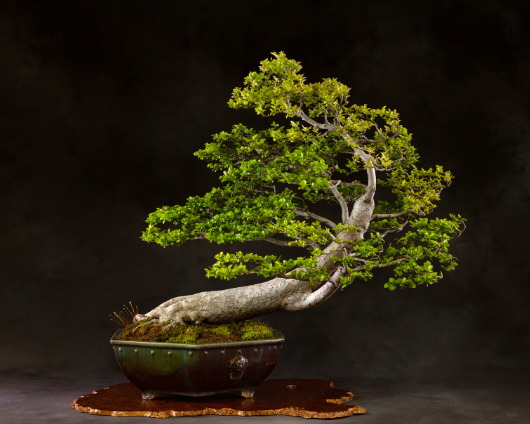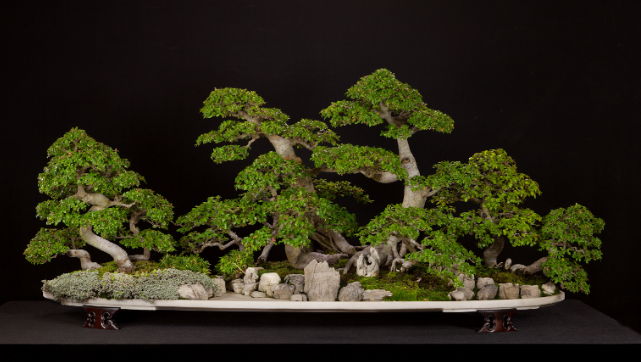The National Bonsai & Penjing Museum is home to a breathtaking penjing collection housed in the Yee-sun Wu Chinese Pavilion. This month’s Historical Tree Spotlight draws your attention to a Japanese black pine (Pinus thunbergii) from Dr. Yee-sun Wu, whose trees initiated the foundation of the Museum’s Chinese collection and who financially supported the pavilion’s construction.
A prominent penjing collector, Wu began styling the pine in 1936 and donated it in 1986, along with 23 other trees of various species. Read more about his personal background here.
This Japanese black pine can be categorized as a tree penjing. “Penjing” refers to scenic landscapes created in trays or ports that often include additions like rocks and ceramic figurines, like a Chinese landscape painting come to life. A pot with a single tree can be called a “tree penjing” but is more commonly known as “penzai,” the Chinese pronunciation of the characters of “bonsai.”
The pine’s exaggerated primary branch, the lowest and longest branch off the right of the tree, is a distinct Chinese tree penjing quality, James said.
“If your eye follows the curvy line of the trunk up and then down that swooping branch, you can see that it gives a playfulness or a whimsical look to the tree,” he said.
Many of Wu’s penjing were trained in the Lingnan style – the clip and grow technique – which his father and grandfather are credited with popularizing. James said the dramatic change in the tree’s direction, led by the primary branch, is consistent with the aesthetics of Lingnan style. The sweeping movement emulates Chinese brush paintings and drawings that, along with scholarly pursuits of poetry and culture, have inspired penjing artists for hundreds of years.
“If you look at a lot of old paintings of trees in China, there are sharp zig zags in the branching with a lot of natural breaks and snaps left in the painting,” he said. “It shows the weathering of the tree and its survival through time.”
This pine inspired the logo used on the cover of a booklet listing the trees Wu gave to the Museum in 1986.
A shot of the pine in its original pot from Wu's second publishing of his book.
Lingnan style technically means “south of the mountains” and strives to reveal but not control the nature of each tree specimen. Because the style encourages spontaneity and whimsy, these penjing appear more natural than bonsai, James said.
He added that the black pine was likely collected and placed in a pot, like many Lingnan trees, rather than grown from seeds. The original pot is a traditional deep penjing container that fosters strong tree growth, which is useful when trees are first developing. Now that the penjing is more mature, it tolerates the shallowness and size of its current pot, which retains water well and restricts root growth, facilitating shorter branches.
Wu wrote in his book Man Lung Garden Artistic Pot Plants: “The challenge of art in penjing consists of uniting within the same pot the three elements from Chinese proverbs: ‘heaven, earth and man.’”
Caring for the pine
James hesitates to categorize this tree as completely Lingnan because black pines will die if they are constantly clipped back. Evergreens, like black pines, are typically treated with decandling, or the process of removing a first flush of foliage growth to create a second flush of needles shorter than the first. Shorter needles are in better proportion to small trees in containers and increase the trees’ ramification, or number of branch bifurcations, James said.
He added that Museum staff do the bulk of the work on this black pine between June and July, when decandling should be performed. Decandling the pine too early would produce lengthy needles in its second flush of growth, but decandling too late doesn’t give the second growth spurt time to harden before winter.
From August on, James and the Museum team remove old needles with fingers or tweezers. Black pines in the wild retain needles for multiple years, but James said they must remove the older needles periodically to help light filter through the top of the tree to lower foliage.
“We pull more needles in stronger areas and less in weaker spots,” James said. “This practice makes the black pine look neater and balances the growth.”












